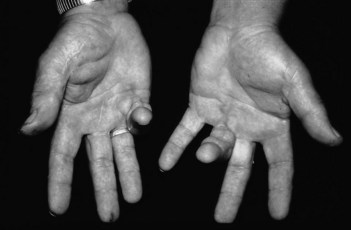219 Dupuytren’s contracture
Salient features
Examination
• Thickening of the palmar fascia, particularly along the medial aspect (feel for thickening before you comment on it).
• In almost all cases, the fourth finger is affected with associated involvement of fifth, third and second fingers in decreasing order of frequency (Fig. 219.1).
• Perform the Hueston tabletop test: if the patient is unable to lay his or her palm flat on a tabletop, the test is positive.
Advanced-level questions
Why is the deformity caused by this condition usually well tolerated?
Because it exaggerates the normal position of function of the hand.
How would you manage such patients?
Treatment depends on the severity of findings:
• Periodic examination of patients in early stages. If the palmar thickening is growing rapidly, local injections of triamcinolone into the growing nodule may be of benefit and reduce the need for surgery.
• Collagenase from Clostridium histolyticum, which lyses collagen and leads to disruption of contracted cords, is a new option for the therapy of advanced Dupuytren’s disease. Collagenase clostridium histolyticum significantly reduces contractures and improves the range of motion in joints affected by advanced Dupuytren’s disease. Therapy does not require anaesthesia. The collagenase is injected into the affected cord, and the treated joint is manipulated the next day to attempt cord rupture. Extensive hand therapy after treatment is not required (N Engl J Med 2009;361:968).
• Surgery is indicated when there are disabling flexion contractures (when the metacarpophalangeal joint contracture is >40 degrees or when the proximal interphalangeal joint contracture is >20 degrees), although recurrences are common (Lancet 1997;350:1568). The surgical procedures include open fasciectomy (the most common procedure), percutaneous or open fasciotomy, or needle fasciotomy.








